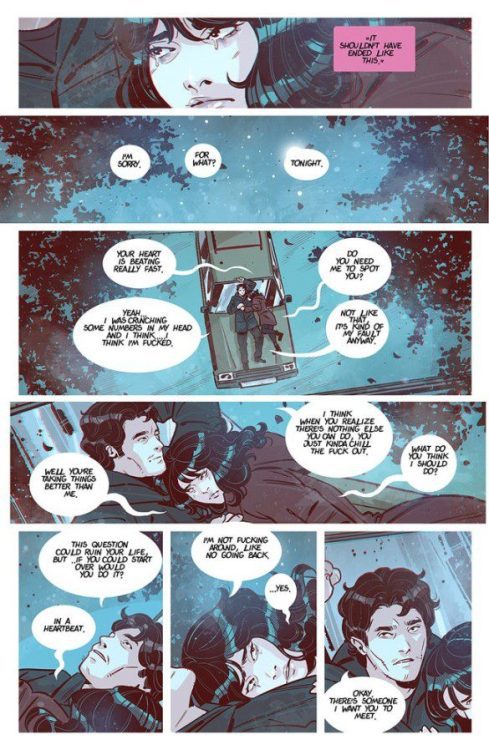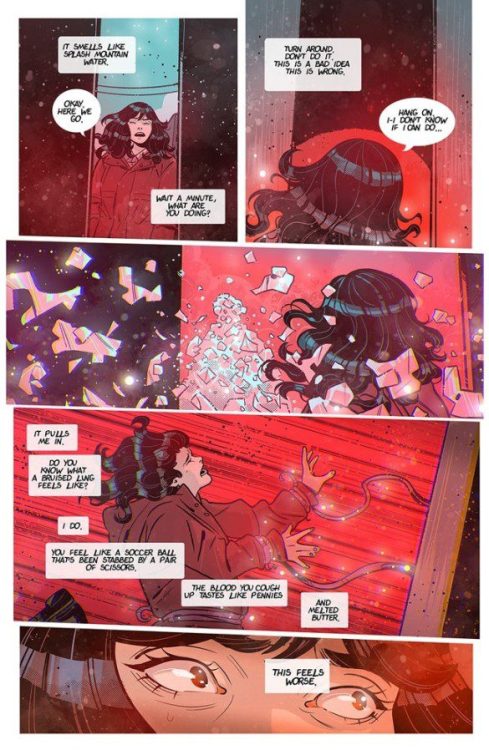From writer Wyatt Kennedy and artist Luana Vecchio comes Bolero #1, a debut comic with a serrated edge dipped in young love, heartache, local punk, and interdimensional travel. While it certainly has some rough edges, this issue keeps its audience engaged with great characterization and perfectly fitting visual design.
“A woman running away from a broken heart discovers a mother-key into parallel universes. The rules are: The key can work on any door. The mother will only let you visit 53 universes. Do not ask to speak to the mother. Never hop more than 53 times.”
Writing & Plot
Wyatt Kennedy’s script for Bolero #1 fuses relatable character drama with crazy sci-fi hijinks in a compelling – if not a bit stilted – manner. Our protagonist Devyn is like a romanticized version of a person you have most definitely met. In fact, almost everyone in this book is like that. If you’ve ever been to a local band’s show in a dingy venue that used to house a random small business but is now empty and smells like piss and PBR, you have met these people. Devyn’s fractured relationship with her parents and fiery (yet doomed) new romance and tattoo apprenticeship are semi-relatable…in a very vibes kind of way. This comic feels like an episode of Euphoria, but with hints of Saga and Scott Pilgrim Vs. The World. This is a comic made for the current generation and their sensibilities, but with the neon-tinged lens of Gen Z L.A.
The main character storytelling is so compelling that by the time the interdimensional stuff shows up, it feels like a distracting afterthought. Don’t get me wrong, I quite like the sci-fi elements this comic brings in. I was just so invested in Devyn and her trials & massive screwups that I wanted to hurry through the weird stuff and back to her grimy L.A. life. The core premise of the series is presented at this point, and it is one built on this character’s pain and all the failings that have happened to her. The chance to start over blank slate is one many can relate to, and while it’s immediate presentation felt almost like an interruption, I’m thoroughly compelled by where this story will go.
There’s a note I feel I should add regarding a writing decision made towards one of the characters. Devyn’s romantic partner Natasha happens to be a trans woman. The way we find this out is through a a single ham-fisted line regarding her dead name (that is, the name Nat would have used before she transitioned). I understand that writing a trans character and making it known that they’re trans is a bit tricky without falling into any stereotypical issues. It has to be said though, Devyn noting that she “didn’t ask for her (Nat’s) deadname” as if that’s a major feat, was definitely not the way to go. This could be a character flaw – I mean, Devyn is made out to be a very flawed, broken individual. Regardless, let this be a lesson.
Art Direction
Artist Luana Vecchio brings the exact mood, tone, and aesthetic to life for Bolero #1. Every panel looks like it is made of solidified dream-stuff. Her sense of detail in the environments screams that she knows *exactly* what each of these moments looks like. It’s proof of good visual reference. Her character’s outfits are like this as well, with clothing that looks like the stuff worn by the folks who go to local shows with no A/C and $2 beers.
Her colors are what really bring this book’s aesthetic together. Vecchio brings consistent neon hues to every page, typically consisting of deep greens, light blues, purples and pinks. We in the twitter-sphere know this as “bisexual lighting.” It’s a look that very much fits the exact vibe this comic goes for. Her panel design is unpredictable and brilliant. She often overlays panels showing simultaneous events, but in non-parallel ways. She never loses sight of the story’s trajectory though, and the plot is always easy to follow.
The only complaint I have would be regarding her character designs themselves. Her animations are solid. However, she runs into the not uncommon problem of a “sameness” across the facial designs of multiple characters. Their overall feature set and individual aesthetics makes them easy to tell apart in everything else, but when you look at two characters next to each other it becomes a bit obvious. Overall, Vecchio crafts a visual tone that captures the exact vibe this comic goes for and is sure to attract a dedicated readership.
Verdict
Bolero #1 is an atmospheric and compelling opening chapter of young angst, pain, and the longing to leave town and do it all over again. Wyatt Kennedy’s script makes a couple faux pas, but still comes across as heartfelt and will no doubt be relatable to a large portion of a generation. Luana Vecchio’s visuals, while a little same-y in regards to facial design, are detailed and aesthetically nail the neon-doused mood that is draws the audience in. If this brand of alt-tinged and emotionally heavy sci-fi is your cup of tea, be sure to grab a copy when it hits shelves on 1-19!

